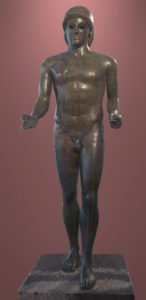Apollo from Piombino
Have you ever heard of archaeological findings in the sea? For sure everyone knows the famous Riace Bronzes accidentally spotted in the sea by a diver. They were recovered and are now preserved at the National Archaeological Museum of Reggio Calabria.
Another famous statue found in the sea is the Apollo of Piombino. It portrays the entire figure of a naked, handsome, standing young man. Perhaps it represents Apollo, the god of beauty and sun: he has a mysterious smile and an elaborate hairstyle with curls and a ponytail. The statue is in bronze and features copper details (lips, eyebrows and nipples) and is 115 cm high. It was fished out of the sea, where it had remained for centuries following a shipwreck in the Gulf of Baratti, off Populonia, not far from Piombino, Tuscany. The discovery was made in 1832. The statue was purchased, in 1834, by the Louvre Museum in Paris, where it is still preserved. The date is debated by scholars: some say it is Greek and dates back to the 5th century. B.C., others claim that it is from the Hellenistic period or from the 1st century B.C., when it was probably crafted for a refined Roman client, particularly passionate about Greek art. Others affirm that it is a lamp holder (in this case, it could be similar to another statue found in Pompeii with the same posture and with the right hand stretched out as if to support something) or, perhaps, a kouros (‘boy’ in ancient Greek) bringing an offering.
The Archaeological Museum of the University of Pavia possesses a plaster cast of this statue purchased at the beginning of the 20th century for study purposes. Instead of studying a photograph of a statue, it is certainly more useful to examine a three-dimensional and real-size plaster copy: a great benefit for students and visitors alike. We look forward to welcoming you to the museum to admire it as soon as the pandemic is over!
In the photographs, we compare the original, in bronze, to the white plaster cast.


